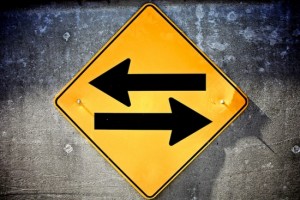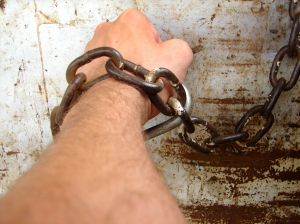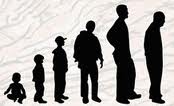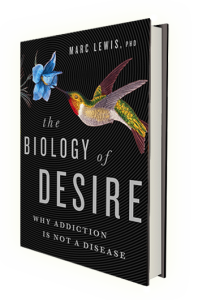By Persephone…..
(This piece was sent to me by a member of this blog community, and I think it’s incredibly astute and revealing. As a developmental psychologist, I strongly agree that the recovery process should be viewed as developmental, not static. P.S. It’s apparently no longer be-nice-to-12-step week.)
 After I had been clean for what one member counted as 17 months, I finally went back to an NA meeting, only to discover that there is such a thing as being held in stasis in recovery — and that I had, myself, been there. I was acutely aware before, but even more by that point, that for many of my 12 step instructors (for lack of a better word) we were supposed to freeze ourselves in that very moment in which we finally realized that we were “diseased” and had decided to devote ourselves to recovery. We were to cling to that moment in time, reaching backwards instead of forward, into the depths of our misery lest we forget it, developing emotionally only artificially via these 12 steps but otherwise staying rather static in some very crucial ways. So, I watched as roughly 30 people recounted, and with the same stories I had observed over 17 months prior, the worst moments of their addiction. Having not been in a 12 step program since getting clean, but rather in trauma therapy (when I had any therapy at all) as well as restructuring my life on my own based around my new-found loves of self-restraint and goal oriented thinking (not to mention just plain having fun), I could only see in these shares shadows of my past. My very sick past, and one in which I was unable to achieve any kind of “recovery”. I could also see exactly what my therapist always warned as dangerous in terms of staying in the moment and forcing oneself to relive past traumas, though my new and healthy brain had already directed me against this sort of thinking. Very far away from this kind of thinking, so why was this not the case in the most well-known substance abuse venue in the western world?
After I had been clean for what one member counted as 17 months, I finally went back to an NA meeting, only to discover that there is such a thing as being held in stasis in recovery — and that I had, myself, been there. I was acutely aware before, but even more by that point, that for many of my 12 step instructors (for lack of a better word) we were supposed to freeze ourselves in that very moment in which we finally realized that we were “diseased” and had decided to devote ourselves to recovery. We were to cling to that moment in time, reaching backwards instead of forward, into the depths of our misery lest we forget it, developing emotionally only artificially via these 12 steps but otherwise staying rather static in some very crucial ways. So, I watched as roughly 30 people recounted, and with the same stories I had observed over 17 months prior, the worst moments of their addiction. Having not been in a 12 step program since getting clean, but rather in trauma therapy (when I had any therapy at all) as well as restructuring my life on my own based around my new-found loves of self-restraint and goal oriented thinking (not to mention just plain having fun), I could only see in these shares shadows of my past. My very sick past, and one in which I was unable to achieve any kind of “recovery”. I could also see exactly what my therapist always warned as dangerous in terms of staying in the moment and forcing oneself to relive past traumas, though my new and healthy brain had already directed me against this sort of thinking. Very far away from this kind of thinking, so why was this not the case in the most well-known substance abuse venue in the western world?
I understand the 12 step idea of reliving these dark times, and I am aware that this does help some people whose struggle with their own addiction requires constant reminders of how bad their lives get if they use or drink, lest they are tempted to casually or socially (moderate) use or drink. The fact is that this does not help everyone who has struggled with substance abuse, nor is it an idea much found (at least not by me) in other areas of psychology, certainly not in the areas of trauma and abuse. For many, much like the stages of grieving or healing from traumas by emotionally processing them in stages, healing from addiction (and reaching the state of having recovered) requires emotional growth. Change. Realizing that we have made mistakes, and learning from them — while critically gaining self-esteem and the confidence that comes from our own successes in the process. Learning, in a sense, to ride without the training wheels, even if it results in a few scuff ups along the way.
I realized while listening to these shares (over 30) that none of this emotional development had taken place with the members of this particular group. Hopelessness, anxiety, and the common thread that the “disease” was still very present (and quite personified, doing push-ups in the parking lot and lurking around every corner just waiting to flare back into active addiction), even in the relatively normal actions and thoughts these people had experienced that day. They were still experiencing the anxieties and fears I by then had come to associate only with active addiction and very,  very early sobriety. Not being trained in psychology but having had my fair share of trauma counseling and the usual smattering of readings about trauma and abuse, I also associated these problems as being almost akin to PTSD, which is almost by definition a state of stasis in which one cannot process or heal from a traumatic experience.
very early sobriety. Not being trained in psychology but having had my fair share of trauma counseling and the usual smattering of readings about trauma and abuse, I also associated these problems as being almost akin to PTSD, which is almost by definition a state of stasis in which one cannot process or heal from a traumatic experience.
Yet even in my tattered memory, I was acutely aware of what I was taught during my short tenure in NA and the inevitable stint in a 12 step rehab that followed (I say this not to offend adherents to the 12 step method, but to stress that the effect this static-not-developmental treatment had on me was to, well, keep me in my addiction — which for me was synonymous with hopelessness and trauma.). I, and the others, were told that we must essentially live with clipped wings. If we were allowed to ever truly fly, we’d surely be conquered by our own “self-will” and excesses of ego. Anger and hatred (“resentments”, in 12 step parlance) were to be eradicated. How we were supposed to do this without extreme amounts of repression (or a particularly intense spiritual experience) was rather beyond me, and frankly it was my anger that was keeping me going. I consider anger now a useful stage of sorts in my  development as a now-recovered person, much like the anger in the often quoted stages of grieving. But no, never in “recovery”. “Resentments” lead to relapse, we were taught. We were to progress only through the steps, despite our various ideological differences with them, but never through normal human emotions. We were all taught that we were faulty, that our brains were faulty from birth, that we were born addicts and must consider our brains to be diseased until the day we died.
development as a now-recovered person, much like the anger in the often quoted stages of grieving. But no, never in “recovery”. “Resentments” lead to relapse, we were taught. We were to progress only through the steps, despite our various ideological differences with them, but never through normal human emotions. We were all taught that we were faulty, that our brains were faulty from birth, that we were born addicts and must consider our brains to be diseased until the day we died.
Stasis.
Conversely, we were supposed to also ruminate endlessly on our own thoughts (which for me is an excess of ego I don’t prefer to allow!) and stay in the exact same mode of instant gratification that we were in as active addicts and alcoholics (or both). This, in retrospect, is what I find almost the most damaging. There is no emotional development possible, at least not for me, if I’m to still be obsessively thinking about, well, my own obsessive thoughts! Certainly not if my response to a thought I find possibly “diseased” is absolutely and immediately to call my sponsor and then promptly get to a meeting — it’s still instant gratification. This is the same model of living I (and other addicts/alcoholics) had experienced while using and drinking, living from moment to moment with our thoughts focused on getting a substance into our bodies — NOW!! — and getting that instant gratification of a high, a buzz, whatever you choose to call it. In my meetings and rehab, it was still the same, just an instant gratification based on an anxiety-centered thought process. How this would bring me, personally, to “serenity” was rather beyond me. Perhaps the idea was to confuse me to sobriety?
Why not encourage patterns of thinking that don’t simply state that you must get to the serenity point (while remaining in a process in which every thought must be immediately pounced  upon and discussed — instant gratification) but instead encourage goal-oriented thinking? I understand that this is hard for the “newcomer” to grasp, but after a few months (at most), introducing at least some ideas beyond the over-arching one of staying in sobriety might be at least somewhat helpful! Acceptance (“live life on life’s terms”) was also to be implemented immediately, not arrived at by experiencing other basic human emotions relating to our situations, such as anger, not even the bargaining listed in the well known grief list. Of everything, what I view as most valuable is that people must process their emotions, even the ones not deemed acceptable (acceptance!) by the creators of Alcoholics Anonymous. That people must learn, and that they must develop. That sometimes true acceptance is the ability to finally move on and leave behind the stasis caused by endlessly repeating stories of the lowest lows.
upon and discussed — instant gratification) but instead encourage goal-oriented thinking? I understand that this is hard for the “newcomer” to grasp, but after a few months (at most), introducing at least some ideas beyond the over-arching one of staying in sobriety might be at least somewhat helpful! Acceptance (“live life on life’s terms”) was also to be implemented immediately, not arrived at by experiencing other basic human emotions relating to our situations, such as anger, not even the bargaining listed in the well known grief list. Of everything, what I view as most valuable is that people must process their emotions, even the ones not deemed acceptable (acceptance!) by the creators of Alcoholics Anonymous. That people must learn, and that they must develop. That sometimes true acceptance is the ability to finally move on and leave behind the stasis caused by endlessly repeating stories of the lowest lows.
I could at that meeting, and now at past the two year mark of getting clean, see quite clearly that the anxiety and obsessive thoughts I was experiencing at the time were a result of the opiates I was addicted to and the fear of withdrawing from them. For me, and no doubt many others (and I have now met a great many others like myself who have recovered — again, past tense), the removal of the substance and consequent healing of the brain were what did the trick. For me, remaining constantly frightened and anxious would have retarded any personal development, but would’ve been reinforced by the 12 step system had I stayed involved with it. And I see that most clearly when I look at my life now as being so different from the many lives still stuck at a static point — a static point in what should be a process of emotional development — or at the very least the foundation for a new beginning.
 and use. You should just give up and settle for less, because this isn’t gonna get any better. Besides, nobody will know…or care.
and use. You should just give up and settle for less, because this isn’t gonna get any better. Besides, nobody will know…or care. One of the Trumpocalypse’s unintended contributions to the rational world was the reminder that not everything we hear on the news is real. Neither is everything we hear in our heads — especially the automatic negative thoughts blaring from our own fake news channel.
One of the Trumpocalypse’s unintended contributions to the rational world was the reminder that not everything we hear on the news is real. Neither is everything we hear in our heads — especially the automatic negative thoughts blaring from our own fake news channel. I’ve noticed that, when I was an in-patient or in a treatment program, the fake news network stopped broadcasting, or at least I couldn’t pick it up. I was always puzzled that whenever I was in treatment, I’d do great. Just being there sharpened my awareness. When I came out I’d go along great for a while and then tank. One likely reason: my fake news sources were back in action, broadcasting loud and clear.
I’ve noticed that, when I was an in-patient or in a treatment program, the fake news network stopped broadcasting, or at least I couldn’t pick it up. I was always puzzled that whenever I was in treatment, I’d do great. Just being there sharpened my awareness. When I came out I’d go along great for a while and then tank. One likely reason: my fake news sources were back in action, broadcasting loud and clear. Fake news triggers urges, and vice versa. The satellite feed for the lead story originated long ago and far away — for some of us the stories started in early childhood. The stories can be as incessant as muzak playing over and over in your head. We have to change the channel to stay ahead of it…to stay in front of the fuck-its. Because when do the fuck-its happen? When terrorists demand action, now — no time to stop and think — or else.
Fake news triggers urges, and vice versa. The satellite feed for the lead story originated long ago and far away — for some of us the stories started in early childhood. The stories can be as incessant as muzak playing over and over in your head. We have to change the channel to stay ahead of it…to stay in front of the fuck-its. Because when do the fuck-its happen? When terrorists demand action, now — no time to stop and think — or else. Fake news is now not only a meme but an apt tag for the harmful diatribes that go off in our heads and often drive our behavior. But if we can recognize them, we can label them, and if we can label them, we can stop listening. If we can slow down enough to classify the news as real or fake, then, if it’s fake, we can turn down the volume — all the way down.
Fake news is now not only a meme but an apt tag for the harmful diatribes that go off in our heads and often drive our behavior. But if we can recognize them, we can label them, and if we can label them, we can stop listening. If we can slow down enough to classify the news as real or fake, then, if it’s fake, we can turn down the volume — all the way down.



 Informed by unparalleled neuroscientific insight and written with his usual flare, Marc Lewis’s The Biology of Desire effectively refutes the medical view of addiction as a brain disease. A bracing and informative corrective to the muddle that now characterizes public and professional discourse on this topic.” —Gabor Maté, M.D., author of In The Realm of Hungry Ghosts: Close Encounters With Addiction
Informed by unparalleled neuroscientific insight and written with his usual flare, Marc Lewis’s The Biology of Desire effectively refutes the medical view of addiction as a brain disease. A bracing and informative corrective to the muddle that now characterizes public and professional discourse on this topic.” —Gabor Maté, M.D., author of In The Realm of Hungry Ghosts: Close Encounters With Addiction
Recent Comments